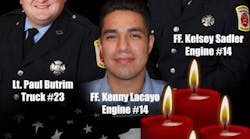This column is a component of VFIS' "Operation Safe Arrival" initiative, aimed at heightening safety awareness and reducing the frequency and severity of accidents involving emergency vehicles.
Many years ago, fire and EMS personnel were considered virtually "untouchable" when it came to accidents or malpractice. Things have changed considerably. The principle of public kindness is no longer an acceptable practice, and concepts such as sovereign immunity (individual vs. government) have been significantly limited by the courts. In fact, many federal, state, and provincial laws allow for suits against individual leaders of emergency service organizations. Terms such as "duty of care," "breach of omission or commission," and "joint and several liability" are now entering emergency personnel's vocabulary.
One important way to prepare for this challenge is to develop, adopt and continuously practice a comprehensive set of Standard Operating Procedures (SOPs)/Standard Operating Guidelines (SOGs.)
While a wide variety of subjects should be covered in a comprehensive set of SOPs and SOGs, one of the most important is the operation of emergency vehicles. Chief officers as well as drivers need to recognize the fact that emergency vehicle response is the basis for the success or failure of all other emergency functions. These expensive vehicles carry all of your portable equipment in addition to your personnel. Allowing an individual to sit behind the wheel of a 12,000-pound ambulance or a 45,000-pound fire apparatus staffed by your personnel - then permitting them to respond in the emergency mode on busy roadways - is a major responsibility. If your vehicles don't arrive safely at the emergency scene, your organization can't achieve its mission of saving lives and protecting property.
The following are just some of the components that should be included in a comprehensive set of emergency vehicle procedures:
- Driver Selection Criteria
- Driver Qualifications
- Required Training
- Testing And Certification
- Skills Maintenance
- Periodic Recertification
Policies and procedures regarding the actual driving of an emergency vehicle should also be included. These "rules for the road" should include, but not be limited to, the following areas:
- Safety Inspections Prior To Driving
- Driver Behavior
- Use Of Warning Devices
- Non-Emergency Response
- Vehicle Control And Right-of-Way
- Response Speeds
- Intersection Practices
- Passing and Rate of Closure
- Riding Policy
- Backing Up
- Response In Privately Owned Vehicles
Having sound emergency vehicle response procedures practiced and in place will help provide positive direction to both your officers and drivers. They will also help protect your organization against accidents and the public relations nightmares that can occur when a department tries to justify poor safety standards. One warning about SOPs/SOGs, policies, or procedures, however; once adopted, they must be rigorously practiced. Nothing can be more embarrassing than adopting a procedure, say, to regularly inspect brakes, and after a brake failure accident, discovering the brakes have not been inspected in keeping with written internal procedures. VFIS Risk Control Services has developed a complete set of procedures, and communiques, addressing many topics related to vehicle operations. They are accessible on our website www.vfis.com. You may wish to review them and make the necessary modifications that meet the unique needs of your own organization.
Related: Don't Become A Statistic VFIS Operation Safe Arrival Website




